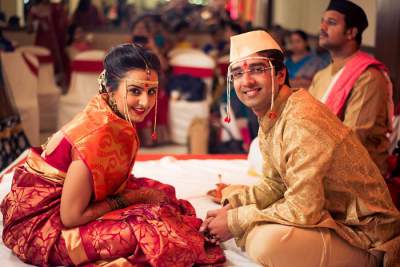Indian weddings are colorful and vibrant ceremonies which unite two different individuals in sacred institution of marriage for consecutive seven births. Maharashtrian wedding or Marathi wedding unlike other regional and cultural wedding is a non-fussy affair. Weddings take place mainly during the day with less grandiose but magnificently. Matchmaking is done, gunas are matched before deciding the auspicious date of taking wedding vows. Read out the traditions and rituals that are followed in Maharashtrian wedding and be a part of this simple and vibrant marathi wedding whenever you get a chance.
In marathi wedding, both the bride and the groom wear mundavlaya on their forehead. Mundavlaya is of two strings made up of pearls and flowers. Groom also adorn topi on his forehead. Unlike other weddings, where a bride wears mukut on her forehead, mudvalaya is different.
Wedding Traditions and Rituals
Ganpati pujan
Lord Ganesha holds lot more significance for Maharastrian people. It is said before commencing any auspicious task, prayer to lord ganesha is offered to that the work get completed without any hindrance. Marathi wedding ceremony start by prayering to the lord of removing obstracles (Vighanharta), ganpati ji so that the marriage is been conducted without any hurdle and to seek his blessings for the married life of the bride and the groom. Ganpati pujan is done at both the places, at bride’s and groom’s home.
Punayvachan
Priest asks bride and bride’s father to have aashirwaad of everyone presents there for happy married life.
Devdevak
In this ritual, devdevak or kuldevta is invoked and prayed to shower blessings on the couple’s marriage life.
Gurihar puja
All decked up in yellow saree, mostly gifted by maternal uncle, adorning jewellery, and a half moon tilak on her forehead, would be bride worships goddess parvati idol mounted on rice for smooth, happy and prosperous married life ahead. She keeps praying until the bride calls to the mandap.
The Antarpat Ritual
The bride is escorted to the mandap where groom is already present. Antarpat is a silk shawl which is held by priest so that the bride and the groom cannot see each other till the hymns (sanskrit and marathi mangalshtakas) are recited. Basically, they are not supposed to see each other until all mantras are chanted.
The Sankalp ritual
When the silk shawl (antarpat) is removed, both the bride and the bridegroom sees each other and exchange floral garlands or jaimalas in front of everyone. All the relatives throw unbroken rice upon would-be couple.
Jhalphirwane Ritual
Jhal phirwane ritual is also known as kanyadaan ritual. Kanyadaan is an emotional ritual where bride’s father gives away her daughter hand to groom’s hand. The groom then tied mangalsutra around bride’s neck and put vermillion (sindoor) in the partition of her hair. After which bride applies sandalwood tikka on groom’s forehead. There is a ritual called kankan bandhane where couple ties a piece of turmeric with the help of a thread on each other’s head.
The saptapadi Ritual
Now the Bride and her respective groom take seven sacred rounds around holy agni kund in which they promise to be there with each other through out lives, supporting and loving each other may whatever comes. Bride touches bettle nuts and heaps of rice with each round.
Karmasamapati Ritual
The Karmasamapati ritual marks the end of wedding ceremony where both couple prays to the holy agnikund for marital bliss. In this ritual, bride’s father or brother playfully twists the groom’s ear to make him aware of the duties marriage demands that she is her responsibility now.

